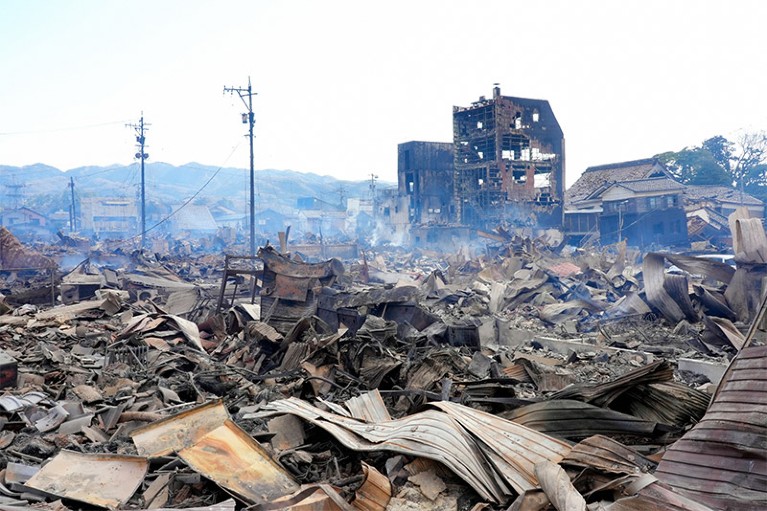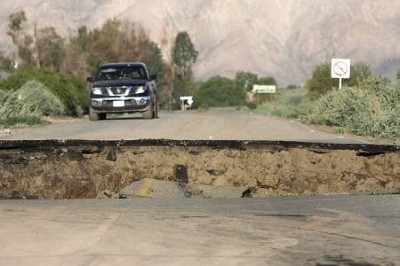
Buildings in Wajima were reduced to rubble by fires that broke out after the earthquakes.Credit: The Asahi Shimbun via Getty Images
This week, a series of powerful earthquakes struck the west coast of Japan, killing dozens of people and reducing many buildings to rubble.
A magnitude-7.6 earthquake hit Ishikawa prefecture on the country’s main island, Honshu, on 1 January. It was the strongest quake to occur in the area in more than a century. “It’s probably one of the largest earthquakes on the west coast of Japan,” says Takuya Nishimura, an earthquake scientist at Kyoto University in Japan.
The massive earthquake prompted tsunami warnings, with ocean waves reaching more than 1 metre high in some areas along the coastline. By the following morning, the Japan Meteorological Agency (JMA) had recorded a further 147 smaller earthquakes on Ishikawa’s Noto Peninsula, including a 6.2-magnitude earthquake. The tremors have resulted in more than 60 deaths, with dozens more expected as rescue teams search through the rubble.
What caused the earthquake?
Table of Contents
Japan is one of the most earthquake-prone countries in the world, because it sits on top of four converging tectonic plates that constantly grind together. Some 1,500 earthquakes strike the country every year, although the majority are too mild to be felt. Most major earthquakes in Japan are caused by the Pacific Plate off the east coast, which slides beneath the North American Plate. This subduction was the driving force behind Japan’s largest ever recorded earthquake — a magnitude-9.1 quake that struck the Tohoku region in 2011 and triggered a massive tsunami — says Yoshihiro Hiramatsu, a seismologist at Kanazawa University in Japan.

AI predicts how many earthquake aftershocks will strike — and their strength
Ishikawa itself is no stranger to earthquakes, with more than 500 occurring since 2020. In May 2023, a magnitude-6.3 earthquake shook the region and destroyed dozens of buildings. But these events are underpinned by a different mechanism from quakes that happen on the eastern side of Japan, says Adam Pascale, a seismologist at the Seismology Research Centre in Melbourne, Australia. Instead of occurring along the boundary of a tectonic plate, the earthquakes in Ishikawa are triggered by faults within the plate itself, which are put under pressure when the tectonic plates push against each other. “That stress builds up in the plate and it’s going to slip somehow,” says Pascale.
Why have there been so many aftershocks?
The main magnitude-7.6 earthquake probably originated from a fault that stretches for 150 kilometres beneath the Noto Peninsula, says Aitaro Kato, a seismologist at Kyoto University. “The source area is very wide,” he says. This giant fracture is of a type known as a reverse fault, which occurs when one slab of rock moves on top of another. But he suspects that multiple fault ruptures inside the plate probably triggered the aftershocks that followed the larger earthquake.
Studies have also shown that fluids deep inside Earth’s crust could also drive earthquakes in Ishikawa. As these fluids well up through the crust, they can weaken the fault zone and cause it to slip, leading to a series of aftershocks following a main earthquake, says Hiramatsu.
How has the country responded?
Since the 2011 Tohoku event, Japan has improved its earthquake early-warning systems, says Kato. Shortly after the magnitude-7.6 earthquake hit Ishikawa, the JMA issued a major tsunami warning and called on residents to evacuate to higher ground.
But the aftershocks have made it difficult for rescue teams to retrieve people who are trapped underneath the ruins of fallen buildings, and they could cause further damage to already weakened structures, says Pascale. “That’s one of the biggest dangers at this point,” he says.
The frequency of aftershocks is expected to decrease in the coming days, but more will probably hit the region, says Nishimura. He adds that another magnitude-6 or 7 earthquake is not out of the question. “We need to prepare.”
